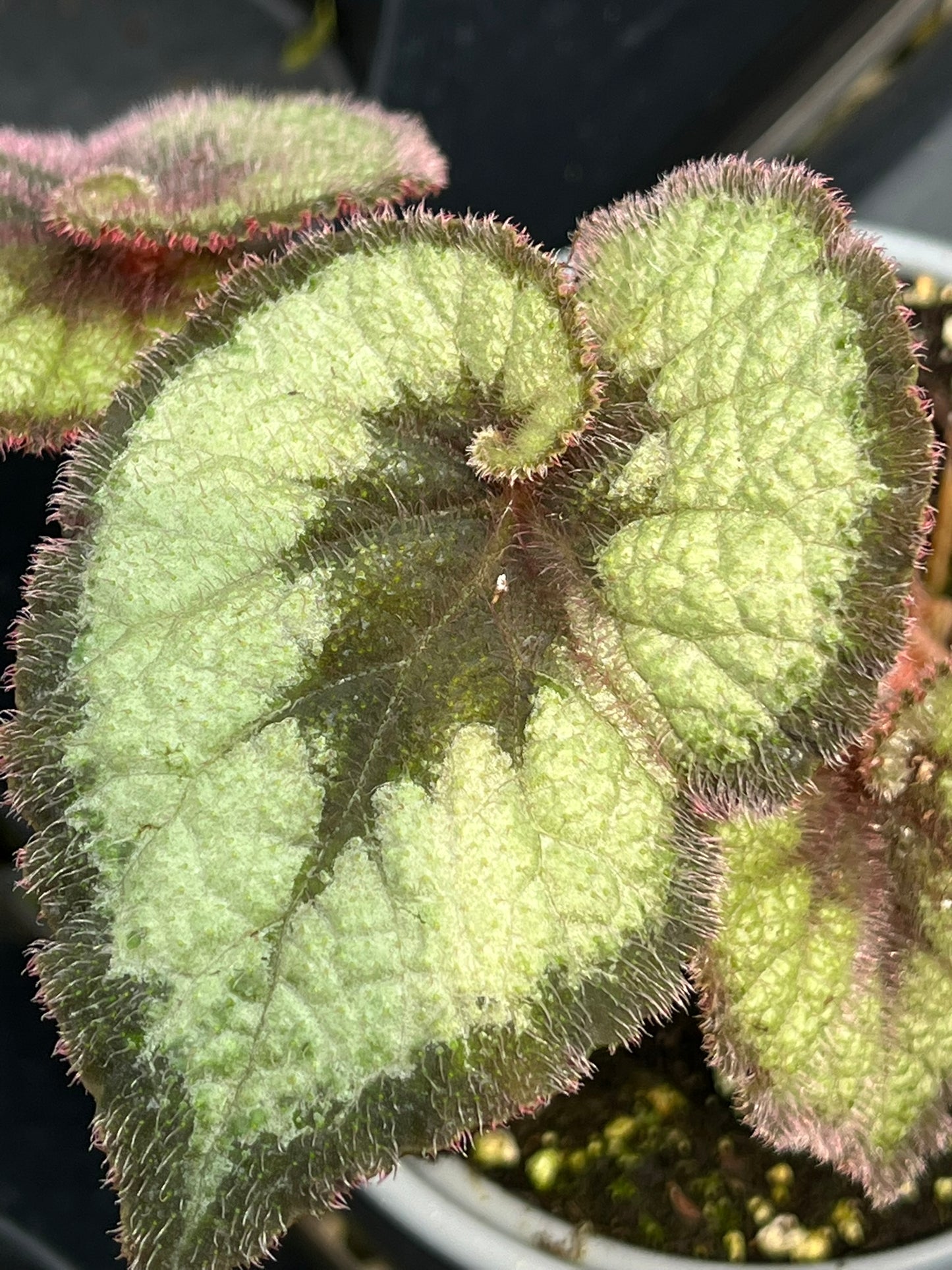Plant Hoarder
Begonia Escargot
Begonia Escargot
Couldn't load pickup availability
Share
Hardiness Zone:9
Sun Exposure:Part Sun, Mostly Shade and Shade
Begonia ‘Escargot’: A Spiraled Masterpiece of Texture and Color
A Complete Growing and Care Guide for This Twisting Beauty
Begonia ‘Escargot’ is one of the most unforgettable foliage plants you’ll ever meet. With its iconic spiral leaf pattern, it looks like something nature painted by hand—elegant, whimsical, and full of charm. Whether you’re an experienced begonia lover or a curious new collector, this Rex-type begonia earns its place center stage with personality and style.
Let’s explore why Begonia ‘Escargot’ is a must-have—and how you can grow it into a thriving, show-stopping part of your plant collection.
What Makes ‘Escargot’ So Special?
The name says it all—“Escargot” is French for snail, and each leaf looks like a green spiral shell, complete with bold patterning and texture.
Here’s why it stands out:
-
Leaf Shape: Large, asymmetrical leaves that twist in a perfect spiral from the base.
-
Color Pattern: Swirls of olive green, silver, and deep chocolate brown form a dramatic visual contrast.
-
Texture: Velvety and slightly crinkled leaves add dimension and depth.
-
Growth Habit: Forms a neat, rounded mound around 12 inches tall and wide.
It doesn’t just grow—it performs. The plant is a living sculpture, always drawing the eye.
Light Requirements: Bright, But No Direct Sun
Begonia ‘Escargot’ thrives in bright, indirect light. Too much direct sun can scorch its delicate leaves and dull its dramatic coloring.
-
Indoors: An east- or north-facing window is perfect.
-
Outdoors: Only in full shade or dappled morning light—never full afternoon sun.
Good lighting keeps the spiral sharp and the leaf colors rich. Poor lighting can cause the plant to stretch or lose its distinctive markings.
Watering: Balance Is Everything
Like many Rex begonias, ‘Escargot’ prefers even moisture but will suffer if overwatered. Here’s how to find the sweet spot:
-
Water when the top inch of soil feels dry.
-
Avoid soggy soil, which leads to root rot.
-
Water at the soil level to keep leaves dry and prevent mildew.
This plant appreciates routine. Sudden dryness or soggy conditions can stress it quickly.
Humidity: Keep It High
Begonia ‘Escargot’ is happiest in moderate to high humidity—think 50% or more.
Ways to boost humidity:
-
Use a pebble tray under the pot with water (without touching the pot bottom).
-
Place near a humidifier, especially in winter.
-
Group it with other humidity-loving plants to create a cozy microclimate.
Dry air leads to crispy edges and unhappy leaves. In contrast, the right humidity keeps everything lush and vibrant.
Soil: Loose and Breathable
The roots need both air and moisture, so go with a lightweight, fast-draining mix.
Try this combination:
-
1 part peat moss or coco coir
-
1 part perlite
-
1 part potting mix or compost
A good Rex begonia mix holds just enough moisture without becoming heavy or compacted.
Fertilizer: Small Doses, Big Results
Feed ‘Escargot’ with a balanced liquid fertilizer (like 10-10-10 or 20-20-20) diluted to half strength once per month in spring and summer.
Skip feeding in fall and winter. The plant slows down then, and excess nutrients can cause leaf burn or poor growth.
Temperature: Warm and Steady
Begonia ‘Escargot’ prefers a temperature range of 60–75°F. It’s sensitive to cold drafts and sudden temperature shifts.
-
Avoid placing it near open windows or vents.
-
Protect it from overnight chills, especially in cooler climates.
If you’re growing it outdoors for the summer, bring it inside before temps drop below 55°F.
Grooming and Maintenance
To keep it healthy and beautiful:
-
Remove dead, yellow, or damaged leaves.
-
Wipe leaves gently with a damp cloth to keep the spiral pattern crisp.
-
Watch for any signs of mildew or leaf spotting—good airflow helps prevent this.
If your plant starts getting leggy, you can prune lightly to encourage bushier growth.
Propagation: A Spiral You Can Multiply
Begonia ‘Escargot’ is easy to propagate by leaf cuttings or rhizome division.
To propagate by leaf:
-
Cut a mature, healthy leaf with the main vein.
-
Press the leaf into moist soil or make small cuts along veins.
-
Cover with plastic or a dome to keep humidity high.
-
Keep in bright, indirect light.
In a few weeks, you’ll see baby plants forming along the vein cuts. It’s pure garden magic.
Pests and Troubleshooting
Here’s what to watch for:
-
Powdery mildew: Avoid overwatering and improve air circulation.
-
Spider mites: Look for tiny webs and treat with insecticidal soap or neem oil.
-
Mealybugs: Spot white cottony blobs? Wipe them off with a damp cloth and use insecticidal spray.
Avoid wetting the leaves. Keep humidity high, but airflow consistent, and you’ll prevent most issues.
Styling Ideas: Show It Off
This begonia doesn’t need flowers to steal the show.
Here’s how to display it:
-
In a clay or white ceramic pot, to let the swirl shine.
-
As a centerpiece on a shaded patio table or in a bright sunroom.
-
Grouped with other patterned begonias, like ‘Black Mamba’ or ‘Looking Glass,’ for a bold foliage display.
-
In a glass cabinet or under a grow light, where its unique shape becomes a conversation piece.
It’s a plant people will stop to admire—and you’ll love showing it off.
Why You'll Love Begonia ‘Escargot’
There’s nothing ordinary about this plant. It’s sculptural, patterned, textural, and always full of surprise.
Here’s why it belongs in your collection:
-
Spiraled leaves that are one-of-a-kind
-
Compact habit that fits anywhere
-
Bold personality with low-maintenance needs
-
Perfect for indoor gardens and shade-loving arrangements
-
A talking point in any plant lover’s home
If you’ve ever wanted a plant that looks like art—and behaves like a well-mannered guest—Begonia ‘Escargot’ is ready to charm its way into your heart (and your plant shelf).


